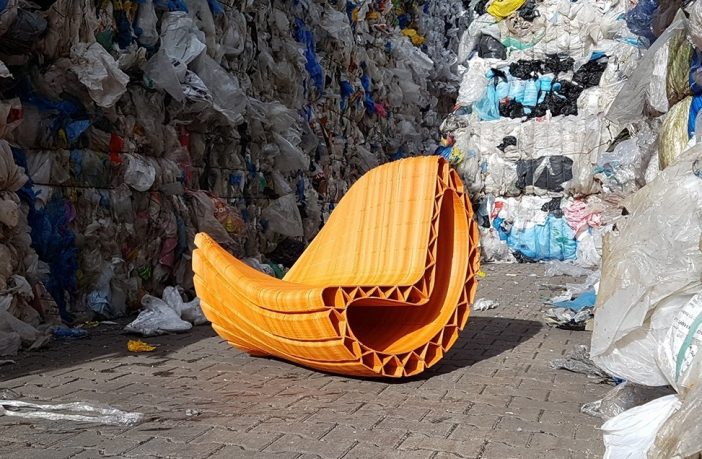Recycling has long been an entry point into sustainable design. It’s personal, achieved at a micro scale where individuals can reduce waste and preserve energy. But between resource shortages, environmental habitat loss and the global climate crisis, there has been a shift in daily practices towards more circular thinking. Increasingly, the need to sustain life is part of a continuous process of production, resorption, and recycling where waste becomes the input for production.

The concept of Circular Design is inspired by processes that self-manage and regulate, considering both time and full life cycles. Looking beyond the current take-make-waste extractive model, a circular approach aims to redefine growth, gradually decoupling economic activity from the consumption of finite resources, and designing waste out of the system. It centers on flows of waste and pollution, keeping products and materials in use, and regenerative natural systems.
Circular Design can reshape how architecture is created. As architect and urbanist Eduardo Souza notes, “Enormous amounts of resources, materials, water, and energy are exploited, processed, and consumed for the execution of a work and limited to the useful life of buildings.” Circular design maximizes more efficient resource management and product life, as well as minimizing or ending waste generation. And these ideas are already being implement in a number of Zero Waste urban initiatives around the world.

Illustrating how ideas of recycling and circular design can be taken to an urban scale, The New Rawlaunched the Zero Waste Lab in Thessaloniki, a research initiative where Greek citizens can upcycle plastic waste into urban furniture. Part of the larger Print Your City project, the project utilizes a robotic arm and recycling facilitates to create custom furniture pieces that close the plastic waste loop. The initiative aims to use flakes from recycled products to redesign public spaces within cities.

These ideas apply to how cities change over time. The Swedish town of Kiruna, 95 miles north of the Arctic Circle, sits atop the largest iron ore mine on the planet. The mine birthed Kiruna – and now, it threatens to erase it. A century of mining operations has begun to destabilize the earth around the city. The ground is breaking, splitting into deep rifts and falling into sinkholes – within the century, these rifts threaten to swallow the town.
In response to this threat, mining firm Luossavaara-Kiirunavaara (LKAB) proposed a direct solution: move Kiruna three kilometers east. In a sense, and at times literally, recycling the city itself. Kiruna’s existing town hall, designed by the Swedish architect Arthur von Schmalensee, receives new life in The Crystal. Henning Larsen’s design incorporates the iconic 1958 bell tower, representing not only a visual re-imagining of Kiruna’s identity but a physical continuation of the town’s history.

The example of Barcelona, characterized by its uniform, regular and extensive grid, shows a solid, mixed and highly dense city with a consolidated public space that needs to reprogram and recycle itself to respond to a rapidly changing social, environmental and economic reality. Leku Studio reimagined the city’s Superblocks Program, one of the most ambitious urban transformations of the city. The toolkit in Sant Antoni is designed following the modulation established by the base mesh being easily aggregated and combined with each other, giving rise to adaptive and circular urban approach.

British multinational infrastructure company Balfour Beatty published a 2050 Innovation Paperlooking at larger trends of circular design and how they might be applied in construction. The industry report has become a reference point on the evolution of building methods, and it outlines how “the Internet of Things will power smart buildings with new, self-healing, energy generating or breathable materials, in smart cities which are able to model the future and adapt instantly to changing circumstances; with 4D printing where self-transforming objects respond to changes in heat, sound or moisture levels to change shape.” Adaptive construction and materials, responsive urban modeling, and 4D printing are all examples tied to circular trends and integrated cities.

Circular design builds and rebuilds overall architectural or urban health. The concept recognizes the importance of design needing to work effectively at all scales – for organisations and individuals, globally and locally. It is a systemic shift that builds long-term resilience to provide environmental and societal benefits. This move allows a radical rethinking of de-materialization, transparency, and feedback-driven intelligence in urbanism. In considering recycling and its urban effects, future cities will increasingly turn to circular design as a way to address the urgent issues of our time.
Author: Eric Baldwin
This article was first published in Arch Daily and is republished with permission.











